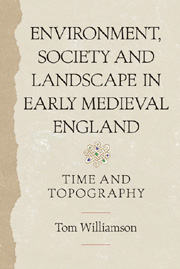Book contents
- Frontmatter
- Contents
- List of Illustrations
- Acknowledgements
- Introduction
- 1 Settlement and Society
- 2 Nature's Frame
- 3 Culture, Ethnicity and Topography
- 4 Small Shires, Deep Roots
- 5 The Gradient of Freedom
- 6 Two Countrysides?
- 7 Village, Farm and Field
- 8 Landscape and Settlement
- 9 Woodland and Pasture
- Conclusion: Time and Topography
- Bibliography
- Index
- ANGLO-SAXON STUDIES
7 - Village, Farm and Field
Published online by Cambridge University Press: 05 April 2013
- Frontmatter
- Contents
- List of Illustrations
- Acknowledgements
- Introduction
- 1 Settlement and Society
- 2 Nature's Frame
- 3 Culture, Ethnicity and Topography
- 4 Small Shires, Deep Roots
- 5 The Gradient of Freedom
- 6 Two Countrysides?
- 7 Village, Farm and Field
- 8 Landscape and Settlement
- 9 Woodland and Pasture
- Conclusion: Time and Topography
- Bibliography
- Index
- ANGLO-SAXON STUDIES
Summary
Core and marginal lands
Many explanations for the divergence of ‘woodland’ and champion landscapes begin from the assumption that the latter represent the core areas of early settlement, denuded of woods and pastures and densely populated by later Saxon times, while the former were characterised by lower population densities, and by extensive tracts of woodland and grazing. These features ensured that ‘woodland’ districts did not experience the kind of resource crisis envisaged by Thirsk, and the consequent reorganisation of settlement into nucleated villages and of the arable land into extensive, regular open fields. The settlement patterns of such districts remained dispersed, and became more so in the course of the twelfth and thirteenth centuries. Yet one of the most remarkable aspects of the debates about regional landscapes is that while such assumptions are endlessly repeated, accepted as fact by many researchers, there is remarkably little evidence to support them. Domesday Book, while it must be used with caution, leaves little doubt that the most densely settled areas of England in late Saxon times, in East Anglia, were not characterised by champion landscapes at all, while the latter correspond, for the most part, with districts which Domesday suggests boasted only moderate population densities, or even densities which were well below the national average (compare Figures 4 and 19).
- Type
- Chapter
- Information
- Environment, Society and Landscape in Early Medieval EnglandTime and Topography, pp. 147 - 183Publisher: Boydell & BrewerPrint publication year: 2012



